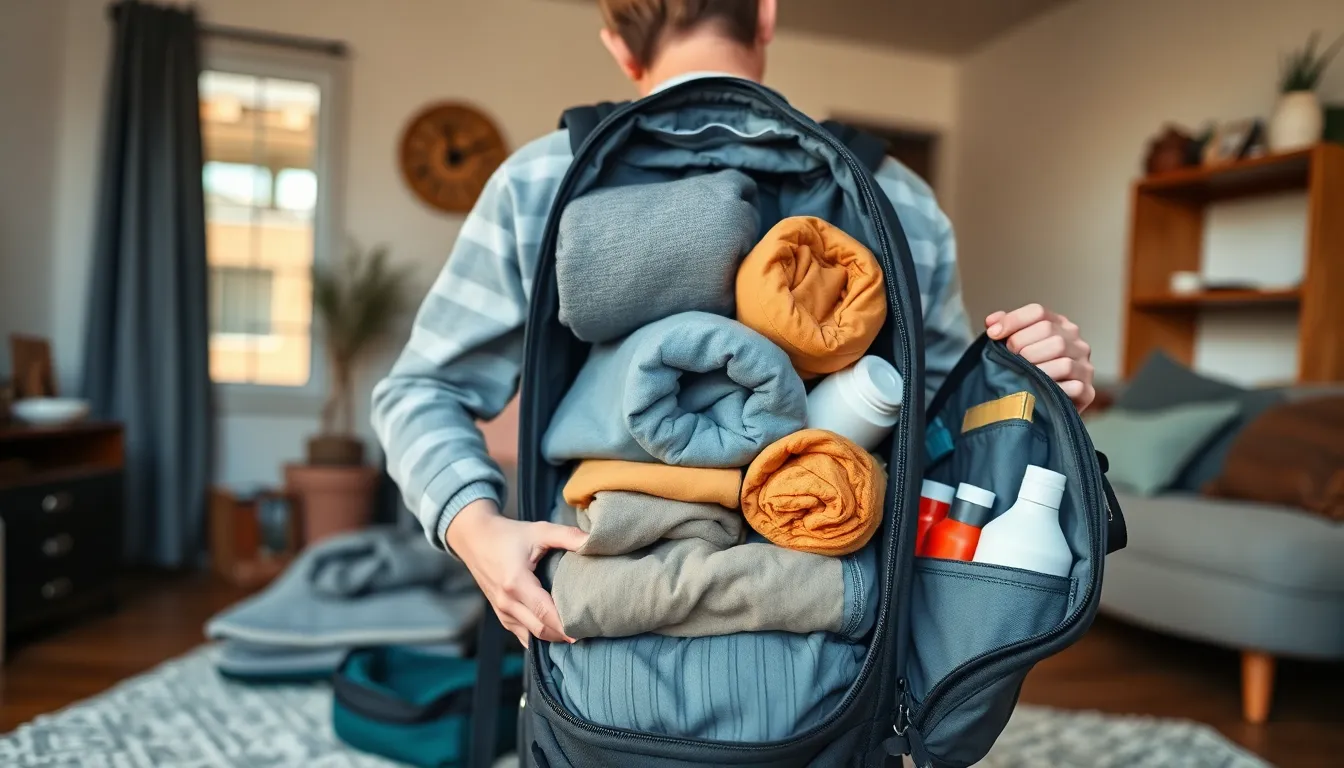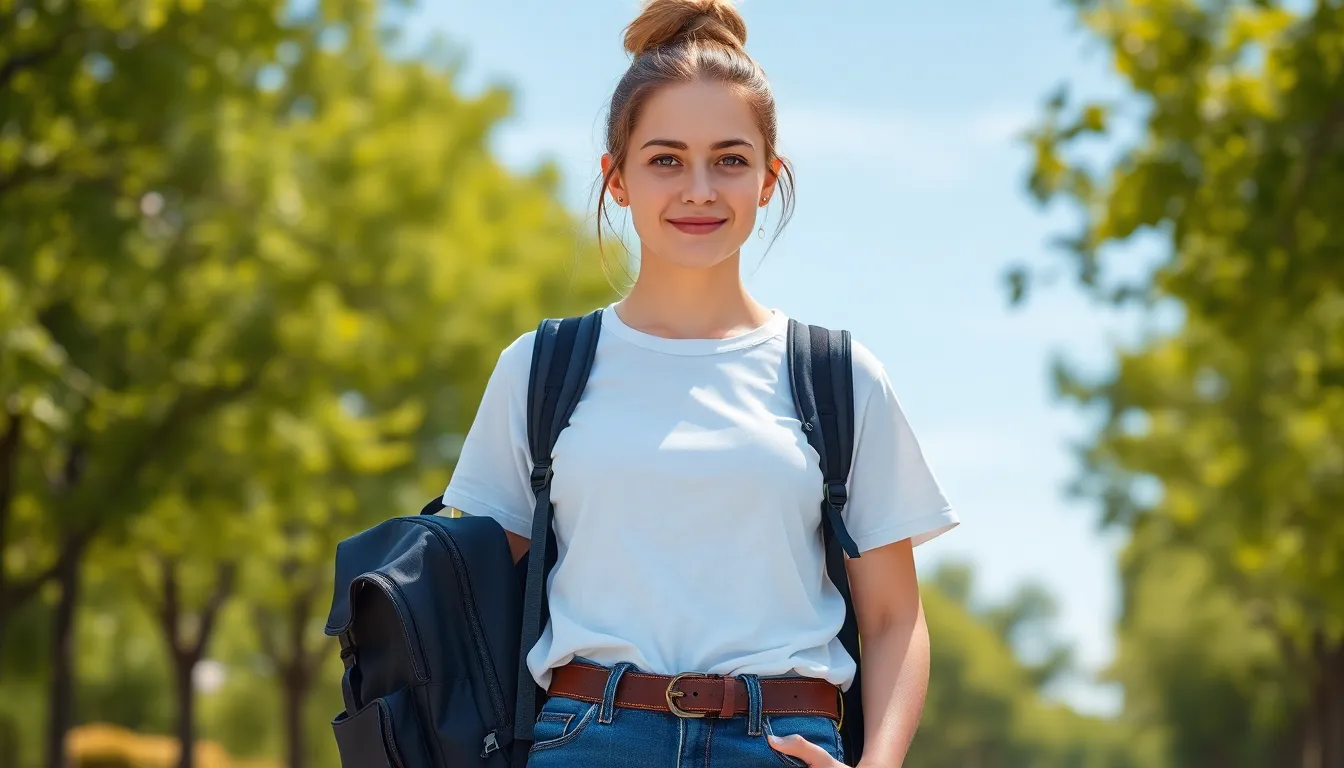Traveling can be exhilarating, but packing often turns into a daunting task. Minimalist packing offers a refreshing solution, allowing travelers to simplify their luggage while maximizing their experiences. By focusing on essentials and eliminating excess, it transforms how one approaches their journey.
This approach not only lightens the load but also encourages mindful choices about what truly matters. Whether it’s a weekend getaway or a long-term adventure, minimalist packing empowers individuals to embrace freedom and flexibility. As they navigate through their travels, they’ll discover that less truly can be more.
Table of Contents
ToggleWhat Is Minimalist Packing?
Minimalist packing streamlines travel by emphasizing essential items while eliminating unnecessary clutter. This approach enhances mobility and encourages intentional packing choices.
Definition and Principles
Minimalist packing focuses on bringing only what’s essential for a trip. The primary principles include:
- Prioritization: Select items based on necessity and versatility. Choose clothing that can be mixed and matched to create multiple outfits.
- Limitation: Establish a strict limit on luggage size or weight. This constraint encourages thoughtful selection of every item.
- Quality over Quantity: Invest in durable pieces rather than numerous cheap items. High-quality items tend to be more reliable and last longer.
- Simplicity: Reduce the number of different types of items. Stick to basics that fulfill multiple functions, such as a jacket that serves as both outerwear and a blanket.
Benefits of Minimalist Packing
Minimalist packing offers various advantages:
- Reduced Stress: Carrying fewer items alleviates the anxiety of managing heavy baggage during travel.
- Enhanced Mobility: Maneuvering through airports, train stations, and crowded streets becomes easier with lightweight luggage.
- Mindful Travel: Encourages thoughtful consideration of what truly matters during a trip. Focusing on experiences rather than possessions enriches travel.
- Cost Efficiency: Saves money on baggage fees and reduces the need for larger accommodations. Traveling light often allows for easier access to budget travel options.
- Sustainability: Lowers environmental impact by minimizing consumption and waste. Packing less promotes a more sustainable travel lifestyle.
Tips for Effective Minimalist Packing

Effective minimalist packing enhances travel by focusing on essentials. Employing specific strategies helps streamline the packing process.
Choosing the Right Gear
Choosing the right gear makes a significant impact on minimalist packing. Select versatile clothing items that mix and match easily; neutral colors often provide more options. Opt for lightweight fabrics that dry quickly, ensuring comfort in various environments. Consider multipurpose items, such as jackets with removable layers or travel-sized toiletries. Prioritize quality, durable products that withstand frequent use and align with a minimalist lifestyle.
Packing Techniques
Packing techniques can greatly improve efficiency. Roll clothing instead of folding to save space and minimize wrinkles. Utilize packing cubes to organize items and enhance accessibility. Place heavier items at the bottom of the bag for better weight distribution. Fill gaps with smaller items, such as socks or toiletries, to maximize available space. Keep essential items like chargers and documents in easily accessible compartments for convenience during travel.
Essential Items for Minimalist Packing
Minimalist packing revolves around selecting key items that enhance the travel experience while minimizing bulk. Focus on these essentials to streamline the packing process.
Clothing Essentials
- Base Layers: Choose breathable fabrics like merino wool or moisture-wicking materials. These layers offer comfort and adaptability across varying climates.
- Versatile Tops: Select 2-3 tops that mix and match easily. Opt for neutral colors and different styles suitable for both casual and formal outings.
- Bottoms: Pack 1-2 pairs of lightweight pants or shorts. Ensure they pair well with all tops for versatility.
- Outerwear: Include a lightweight, packable jacket. This piece provides warmth during chilly evenings or unexpected weather changes.
- Footwear: Limit to 1-2 pairs of shoes. Choose a comfortable pair for walking and a more formal option if needed.
- Accessories: Pack a multi-functional scarf or shawl. This can serve as added warmth, a blanket, or a cover-up in various situations.
Travel Accessories
- Travel-sized Toiletries: Use refillable containers for essential toiletries. This approach reduces waste and complies with travel regulations.
- Compact Tech Gear: Include only necessary electronic devices and chargers. Consider a universal power adapter for international travel.
- Packing Cubes: Utilize packing cubes to organize items within the bag. They enhance efficiency and simplify access to essentials.
- Reusable Water Bottle: Choose a lightweight, collapsible water bottle. Staying hydrated during travel promotes health and saves money.
- Portable First Aid Kit: Carry a small first aid kit with the basics. This ensures preparedness for minor health issues.
- Travel Documents Organizer: Use a slim wallet or pouch to keep passports, tickets, and necessary documents organized. This avoids loss and simplifies access during travel.
Common Mistakes to Avoid
Minimizing packing mistakes can significantly enhance the travel experience. Avoiding these common pitfalls ensures a smoother, more enjoyable journey.
Overpacking
Overpacking remains a frequent error when embracing minimalist packing. It’s easy to inflate luggage with items that may not serve a purpose. To prevent overpacking, travelers should follow these strategies:
- Limit the number of items: Stick to a predetermined number of clothing pieces, typically five to seven, including versatile tops and bottoms.
- Assess needs: Carefully evaluate each item’s necessity before adding it to the bag.
- Check weight restrictions: Verify luggage weight limits to avoid extra fees.
These approaches encourage thoughtful item selection and ensure that bags remain manageable.
Ignoring Versatility
Ignoring versatility undermines the core of minimalist packing. Failing to choose multipurpose items can lead to cumbersome luggage. To promote versatility, travelers can implement these practices:
- Select interchangeable pieces: Choose clothing that mixes and matches easily, like neutral-colored tops and bottoms.
- Use multipurpose accessories: Items like a sarong can function as a blanket, towel, or cover-up.
- Prioritize multifunctional gear: Opt for tech gadgets that serve several purposes, such as a smartphone that functions as a camera and GPS.
These strategies ensure that travelers maximize their packing efficiency while minimizing unnecessary items.
Embracing minimalist packing transforms the travel experience by prioritizing essentials and fostering a sense of freedom. By simplifying luggage and focusing on versatility, travelers can navigate their journeys with ease and confidence.
This approach not only alleviates stress but also encourages mindful choices about what truly enhances the adventure. With effective packing strategies and a keen eye for quality items, anyone can enjoy the benefits of traveling light.
Ultimately, minimalist packing isn’t just about reducing baggage; it’s about enriching the overall travel experience and making each trip more enjoyable.




